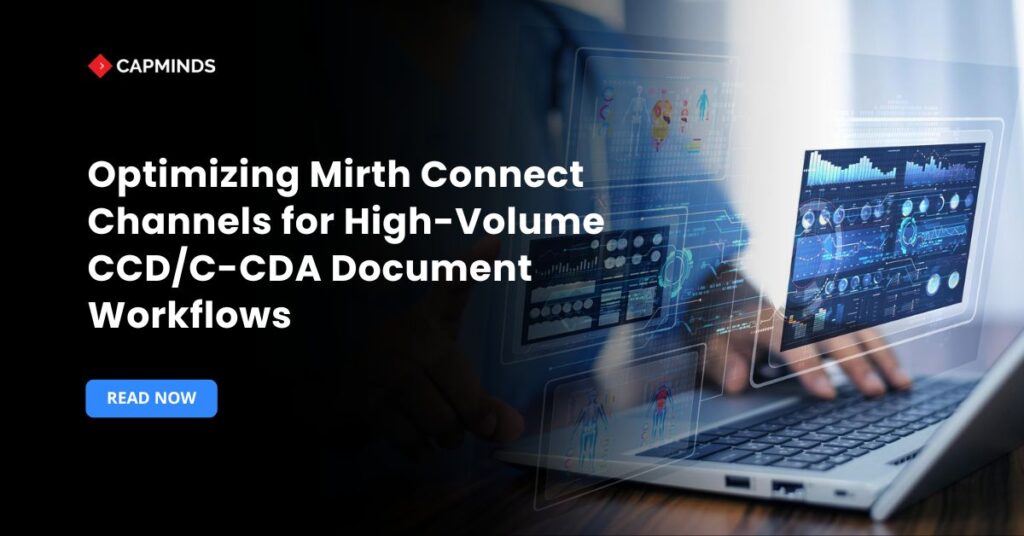Optimizing Mirth Connect Channels for High-Volume CCD/C-CDA Document Workflows
Handling high volumes of Continuity of Care Documents (CCD/C-CDA) is a challenge for hospital IT teams. Large clinical summaries based on XML are commonly encountered in CCD and C-CDA messages. They can quickly strain an integration engine if not properly calibrated.
When you consider the magnitude of healthcare data, the issue becomes even more pressing. By 2025, the world’s healthcare data is estimated to exceed 10,000 exabytes. This rapid expansion explains why robust interoperability is now necessary rather than optional.
Mirth Connect (formerly known as NextGen Connect) has proven itself as a dependable open-source interface engine. Although it is designed to handle complex data interchanges, performance is not guaranteed. To ensure high throughput and reliability, the engine must be carefully configured, fine-tuned, and architecturally designed.
This post provides practical, actionable guidance on optimizing Mirth Connect channels for high-volume CCD/C-CDA workflows. We will discuss performance tuning tips, architectural best practices, and specific channel configuration tweaks to help your hospital interfaces scale reliably.
Understanding the High-Volume CCD Workflow Challenges
1. Large Document Size and Volume
C-CDA documents encapsulate comprehensive patient summaries (problems, meds, labs, etc.), often weighing in at hundreds of kilobytes or more.
Processing thousands of these large XML documents daily can lead to high memory usage, database I/O bottlenecks, and slower throughput if the engine is not optimized.
Each CCD may undergo parsing, validation, transformations (e.g., into other formats or segmented data), and routing to multiple systems. This intensive processing requires both adequate hardware and efficient channel configuration.
2. Performance Implications
Without optimizations, a Mirth Connect channel handling CCDs might experience backlogs, out-of-memory errors, or slow responses. Hospital interfaces often demand near real-time data exchange, for example, sending discharge summaries to health information exchanges or referrals.
High latency or failures in these CCD workflows can impact care continuity and regulatory compliance. The goal is to maximize throughput and stability: i.e., process as many CCD messages per second as possible without sacrificing reliability.
3. Adequate Resources Matter
First, ensure the Mirth Connect server is properly sized. It’s a common pitfall to run Mirth on minimal hardware and expect it to handle dozens of channels.
High-volume environments need sufficient CPU (for parallel threads) and memory (for large message handling). Scale the infrastructure vertically (more CPU/RAM) or horizontally (multiple Mirth nodes) as volume grows. A well-provisioned engine is the foundation for further optimizations.
Related: The Beginner’s Guide to Mirth Connect Channel Architecture
Performance Tuning Strategies in Mirth Connect
Performance tuning in Mirth Connect largely comes down to channel configuration settings that control how messages are stored, acknowledged, and processed. Below are key tuning strategies and how to apply them for CCD/C-CDA workflows.
1. Minimize Message Storage and Disk I/O
By default, Mirth Connect persists message data to its database for tracking and recovery. Writing large CCDs to the database on every step creates disk I/O overhead that can throttle throughput. Adjust the Message Storage settings for each channel to retain only the necessary data.
- Using a lower retention level significantly reduces disk writes per message.
- This improves throughput and lowers memory usage.
- At the “Production” level, incomplete messages will auto-recover on restart; at the “Raw” level, performance is higher, but you’d need to manually reprocess any messages if the server crashes mid-processing.
- Action: In the channel settings, move the Message Storage slider towards “Raw” to limit stored content, while still meeting your auditing/recovery needs.
Also, consider pruning old messages aggressively and using an external database tuned for high write throughput. Reducing the retention window means fewer records for the database to handle, which can dramatically speed up processing in high-volume flows.
2. Use Attachment Handling for Large Payloads
CCD documents can be large, consuming significant memory during transformation. Mirth Connect’s Attachment Handler is a feature designed to offload bulky content. If large message segments don’t need transformation, treat them as attachments.
- The engine will extract that bulk content and handle it separately, rather than loading the entire blob into memory for each transformer step.
- This reduces memory footprint and risk of out-of-memory errors when processing large CCDs.
- Higher throughput results from not repeatedly copying huge strings in memory or writing them to the database unnecessarily.
Action: Configure an Attachment Handler in your channel to specify criteria for what constitutes an attachment. By stripping out large attachments, only the relevant parts of the message go through the transformation pipeline, drastically improving processing speed. The attachments can be stored or forwarded as needed without choking the channel.
3. Enable Asynchronous Processing with Queuing
Source Connector Queuing
Mirth channels normally receive a message and process it before sending an acknowledgment back upstream.
- For high volumes, waiting for full processing for each CCD can slow ingestion.
- If the upstream system doesn’t require a custom ACK from your transformation, you can turn on the Source Queue.
- This means Mirth will auto-acknowledge the message as soon as it’s received and place it in a queue for processing in the background.
- The immediate ACK frees the sender and allows your channel to accept new messages faster, greatly increasing throughput when network round-trip or processing time was the bottleneck.
In the Source settings of the channel, set Queue Messages to Yes. Ensure the default auto-acknowledgment is acceptable for the sending system.
With source queuing, even if the CCD takes a few seconds to process, the sending application isn’t kept waiting; Mirth can concurrently process queued messages behind the scenes.
Destination Connector Queuing
Similarly, if your channel has one or more destinations that do not need to immediately return a result to the source, enable queuing on those destinations.
For example, your CCD channel might write to a database or drop a file, and no immediate response is needed upstream, or perhaps the source already got its ACK as above.
By turning Destination Queue on, the message will be placed on an outbound queue, and the main processing thread can move on without waiting for the external write/post to complete. This is especially beneficial if the destination is slow the channel won’t stall on it. Each queued destination will retry sends independently, and if using multiple processing threads, queued messages can be sent in parallel.
4. Increase Concurrency with Thread Settings
One of Mirth Connect’s strengths is multi-threaded message processing. By default, each channel processes messages one at a time.
- For high-volume CCD workflows where the order of messages doesn’t strictly matter (or can be managed by other means), consider increasing the Max Processing Threads to allow parallel processing of incoming messages.
- For example, setting 5 threads means up to 5 CCDs can be processed concurrently within that channel.
- This can dramatically boost throughput on multi-core servers, Mirth supports scaling up to 64 threads, reportedly achieving over 2,000 messages per second in ideal conditions (for smaller messages; large CCDs will be fewer per second but still benefit from parallelism).
To adjust, go to the channel’s Summary settings and increase Max Processing Threads.
Caution: with threads >1, the channel will no longer guarantee message order. If maintaining order is important, you might leave it at 1 or use the Thread Assignment Variable setting to group messages by a key. The thread assignment allows messages with the same identifier to always go to the same thread, preserving their order relative to each other while still achieving parallelism across different groups.
If order doesn’t matter, simply increasing the thread count and testing throughput is the way to go.
Likewise, if you enabled destination queues, you can raise the Queue Threads setting on a destination connector to send out multiple messages concurrently to that endpoint.
This is useful if the receiving system can handle concurrent connections. For instance, if writing CCDs to an API that supports 5 parallel posts, set Queue Threads = 5 to utilize that bandwidth. Start with a moderate number and monitor throughput, then tune up or down as needed for maximum throughput.
5. Optimize Destination Workflows (Parallel vs Sequential)
If your channel has multiple destination connectors, review how they are set to execute. By default, Mirth can process destinations in sequence or parallel. Disable the “Wait for previous destination” option unless you explicitly need destinations to run one after the other.
Allowing destinations to run in parallel means one CCD can be simultaneously sent to all configured endpoints, reducing total processing time for that message. For example, writing to disk and sending to an API can happen concurrently. Only use sequential execution if there is an actual dependency.
Additionally, if you have multiple destinations but not every message needs to go to all of them, leverage the Destination Set Filter in the source transformer. This feature lets you programmatically route to a subset of destinations depending on message content.
For instance, perhaps in a multi-facility environment, CCDs from Hospital A should only go to Destinations 1 and 2, while Hospital B’s go to 3 and 4. Implementing a destination set filter prevents unnecessary processing on destinations that aren’t needed. This conserves resources and time, especially under high load, by avoiding no-op work.
6. Streamline Transformations and Validation
While not a specific checkbox in Mirth, it’s important to design your transformers and filters efficiently for large CCD content. Use streaming or chunking approaches for very large documents if possible (e.g., use Mirth’s XML streaming API or split the document processing into smaller segments) to avoid building gigantic DOM objects in memory.
If performing XSLT transformations on CCDs, ensure your XSLT is optimized and consider pre-compiling it in the Java classpath for reuse. For JavaScript-based transforms, minimize heavy string manipulation on the entire document; prefer targeted queries to extract only needed fields.
The key is to avoid unnecessary processing. If you only need to change a small portion of the CCD or just route it, do not parse and rebuild the entire XML string.
Similarly, turn off any debugging or message log steps in production channels (such as printing the entire message content to the log on each message). Every extra operation per message adds up under high volumes. Keep the channel logic as lean as possible: only include steps required for the workflow.
Related: Mirth Connect for Multi-Site Healthcare Networks: Overcoming Data Synchronization and Workflow Challenges
Architectural Best Practices for High-Volume CCD Workflows
Beyond individual channel settings, consider architectural decisions that help scale CCD handling across your integration environment.
1. Decouple and Distribute Workload via Channel Pipelines
Monolithic channels that do everything can become a bottleneck. Instead, use multiple channels in a pipeline to break the workflow into stages.
- For example, one channel could ingest CCDs from the source and then route the raw document to downstream channels via a Channel Writer or queuing mechanism.
- Subsequent channels can handle specific tasks: one for data transformation or validation, another for distributing the CCD to various targets.
- This modular approach means each component can be scaled or tuned independently.
- The initial ingest channel can remain lightweight (perhaps just queuing the message), and you can even run multiple instances of subsequent channels in parallel if needed.
In a pipeline, consider using internal queues or a message broker between channels for better resiliency. Mirth’s built-in queuing with the Channel Writer destination or JMS connectors can buffer bursts and ensure no data is lost if a downstream channel falls behind.
The idea is to flatten spikes by queuing and processing at the rate the system can handle.
2. Horizontal Scaling and High Availability
For truly high-volume scenarios, a single Mirth Connect instance may eventually hit throughput limits.
Horizontal scaling can address this: deploy multiple Mirth Connect instances and distribute messages among them. This can be done with round-robin load balancing at the source, or using Mirth’s commercial Advanced Clustering plugin for active-active clustering with a shared database.
Load balancing and clustering help spread the processing load across nodes, improving scalability and robustness. Each node handles a portion of the traffic, preventing any single engine from being overwhelmed. Clustering also provides high availability; if one node goes down, others continue processing.
A common pattern is to front your Mirth instances with a load balancer, or have the source systems configured with multiple endpoints. The Mirth database should be external, robust, and tuned for concurrent access in this case. With clustering, message statistics and states are shared across nodes, which is ideal for coordinated processing. If you don’t have the clustering plugin, you can still operate multiple independent Mirth servers handling different interfaces or facilities to divide the volume.
3. Monitor, Benchmark, and Tune Continuously
Optimizing is not a one-time set-and-forget task. Implement monitoring and logging to continuously track channel performance. Key metrics to watch include: message processing rate, queue depths, processing time per message, CPU and memory usage on the server, and any error rates.
Mirth Connect allows JMX or CLI-based metrics output, which you can feed into dashboards. If using an environment like AWS, you can push metrics to CloudWatch for alerting on slowdowns.
It’s also wise to do regular performance testing on your channels, especially after changes. One approach is to simulate high load with a test channel. For example, we created a performance test channel that loops a sample HL7 message many times and logs metrics like average processing speed and maximum daily throughput capacity. Using such tools or your scripts, measure how many CCDs per minute your setup can handle, and identify bottlenecks.
You might discover, for instance, that the database insertion step is slow or that memory usage spikes at a certain concurrency level, insights that guide further tuning.
- Benchmark tip: Try processing a batch of 100 large CCDs and measure the elapsed time.
- From this, compute an approximate throughput (e.g., 100 messages in 70 seconds ~ 1.43 msg/sec, which extrapolates to ~123,000 per day in one channel).
- This gives a baseline to improve upon.
- Incrementally adjust settings and see if the rate improves without issues.
- Also, test under peak conditions to ensure the engine remains stable.
Finally, configure alerts for when performance degrades, for instance, if a queue starts growing or if processing time exceeds a threshold. Early warning allows proactive scaling or troubleshooting before it impacts downstream systems.
CapMinds Mirth Connect Integration Services
At CapMinds, we understand that high-volume CCD/C-CDA workflows demand more than just configuration tweaks; they require a robust integration strategy.
That’s why our Mirth Connect Integration Services are designed to help healthcare organizations achieve seamless, high-performance interoperability at scale. With our expertise, you gain:
- Mirth Connect Implementation & Integration – Tailored to handle HL7, CCD, C-CDA, and FHIR data at enterprise scale.
- Performance Tuning & Optimization – Fine-tuned channel configurations for high throughput and reliability.
- Scalable Architecture Design – Support for horizontal scaling, clustering, and high availability environments.
- Continuous Monitoring & Support – Proactive issue detection, logging, and optimization for uninterrupted workflows.
- Custom Interoperability Solutions – Integration with EHRs, HIEs, labs, payers, and external systems.
Whether you’re processing thousands of CCDs daily or preparing for future growth, CapMinds ensures your Mirth Connect environment is built for stability, compliance, and scale.
Let’s talk about how our services can streamline your interoperability challenges and future-proof your healthcare data exchange.




